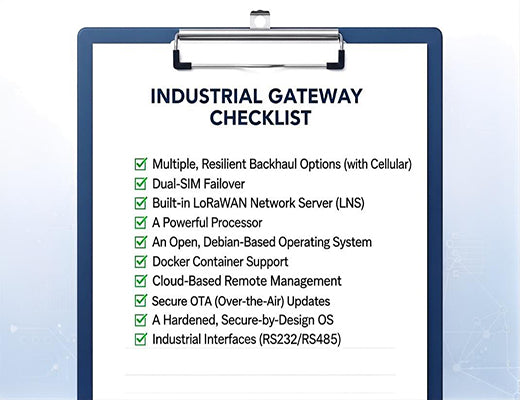
10 Features to Look for in an Industrial LoRaWAN Gateway for 2025
|
|
Time to read 4 min
|
|
Time to read 4 min
Choosing the right LoRaWAN gateway is the most critical hardware decision you'll make for your IoT network. But with so many options on the market, how do you separate the truly industrial-grade devices from the rest?
This guide cuts through the noise and gives you a definitive checklist of the top 10 Industrial LoRaWAN Gateway features to look for.
From resilient connectivity and edge computing power to robust security and scalable management, this is your essential buyer's guide to selecting a gateway that is built for the future.
I've seen too many promising LoRaWAN projects stumble because the team chose a gateway based on price or a single flashy feature. They buy a basic gateway that works fine in the lab, but when they deploy it in the real world, it fails. The internet connection is unreliable, they can't update it remotely, and it lacks the power to perform the simplest local tasks.
When you choose a LoRaWAN gateway for an industrial application, you're not buying a gadget; you're investing in critical infrastructure. It needs to be reliable, secure, and powerful. Forget the marketing hype. This checklist is based on years of real-world deployment experience and focuses on the Industrial LoRaWAN Gateway features that actually matter when your business depends on it.

Here's what separates the best LoRaWAN gateway from the rest of the pack. This checklist covers the essential Industrial LoRaWAN Gateway features you should demand.

When you look at this list, a clear picture emerges. The best LoRaWAN gateway for an industrial application is not just a product; it's a complete platform. It combines rugged hardware, resilient connectivity, a flexible open-source OS, and a powerful remote management system.
By prioritizing these ten Industrial LoRaWAN Gateway features in your selection process, you move beyond a simple proof-of-concept and lay the foundation for a scalable, secure, and reliable IoT network that will deliver value for years to come.

A1: Flexibility and future-proofing. A Debian-based OS gives you access to a vast library of open-source software and allows you to develop custom applications using standard tools like Python and Docker. A proprietary OS locks you into the vendor's ecosystem and limits your ability to innovate.
A2: For non-critical applications, a cloud LNS is fine. But for industrial use cases, a built-in LNS provides critical offline reliability. If your internet connection fails, your local network continues to operate, which is a vital feature for any system that can't tolerate downtime.
A3: In my experience, the most overlooked feature is the quality and capability of the remote management platform. People focus on the hardware specs and forget that the long-term operational cost of managing a fleet of devices is often far greater than the initial hardware cost. A powerful cloud management platform is essential for a low TCO.